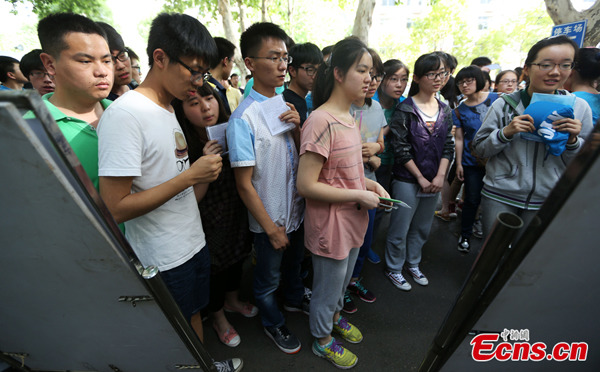
High school students visit exam venues ahead of the national college entrance examination in Nanjing, June 6, 2015. (Photo: China News Service/Yang Bo)
About 9.42 million Chinese high school graduates, slightly less than the population of Sweden, will sit for the national college entrance examination, known as Gaokao, which kicks off Sunday.
The number has marked a tiny increase from that in 2014, which stood at 9.39 million, according to statistics from the Ministry of Education.
The Chinese government has motivated staff nationwide to escort the exam. Police were sent to roads and exam sites for students' security and drivers have been told not to whistle while passing schools and should give way to cars transporting examinee or test papers.
Despite the huge army of high school seniors pursuing higher education, Chinese universities face a growing survival crisis after decades of explosive expansion.
The number of students taking what is generally considered the single most important test any Chinese person can take, has fallen for five straight years since 2009. It peaked at 10.5 million in 2008.
The amount of examinees stopped declining in 2014, but the modest recovery has not brought relief to the looming survival crisis, according to a 2015 report on Chinese university admissions released by China Education online Tuesday.
DIFFICULT TO GET FULL ENROLLMENTS
Universities across China have been facing difficulties meeting recruitment quotas in recent years.
In central China's Henan Province, where the pursuit of higher education is intensely competitive, nearly 70,000 university or college openings were not filled in 2014, accounting for 11.36 percent of the province's total quotas.
Such vacancies have existed for three years in Henan.
Under China's university recruitment system, the central authorities set quotas for university enrollment across provinces and major cities. Students indicate the universities and colleges they want to apply to and their Gaokao test scores are used to allocate spots.
It is the same in Beijing, which is generally considered to have the best universities in China.
The quotas for Beijing students who take the Gaokao was cut to 52,200 in 2014, down 30 percent from 76,700 in 2008.
Unfortunately, the move did not ease vacancies in university recruitment.
Statistics show second-class universities or colleges failed to get full enrollment among high school graduates in Beijing for four straight years, since 2010. Chinese universities are classified on different levels based on their overall strength.
"Chinese universities are undergoing a serious survival crisis, " said Chen Zhiwen, editor in chief of China Education online.
HOMOGENOUS EDUCATION LOSING ATTRACTION
Getting into college does not guarantee a good job upon graduation. This year, nearly 7.5 million students who succeeded at the Gaokao four years ago are still looking for jobs in the toughest job market ever.
Critics say a large number of Chinese universities have been racing to expand their scale by establishing as many majors as they can. Unfortunately, homogenous education intensifies the difficulties in job hunting among college graduates.
"The crisis of recruitment, seemingly an employment problem, is indeed a crisis of declining education quality," Chen warned.
According to the Ministry of Education, Chinese universities added 1,681 majors in 2014, most of which overlapped other majors.
Among them, Internet of Things Engineering was the most popular, with 54 universities or colleges adding the specialty which has already opened in 250 schools.
But even with an excess of trendy new majors, graduates in traditional areas are experiencing difficulties in employment.
Figures from the ministry show college students majoring in English or computer science and technology, each with 100,000 graduates in 2013, found more difficulties in the job market.
MORE PURSUING OVERSEAS STUDY
The emphasis on entrance exams and the lower chances of admission to a top college in China have led more and more parents, especially from elite families, to look for alternatives.
There has been a growing trend of Chinese students applying to universities outside the country.
According to the ministry, nearly one million students who were eligible to take the Gaokao in 2010 decided against it. Of those students, about one-fifth decided to study abroad instead.
Figures from the U.S. backed the phenomenon. The number of high school students in China pursuing higher education in the U.S. hit 110,550 during the period of 2013-2014, a nearly 50 percent increase than that of 2010-2011, said the report by China Education online, citing the Open Doors Report.
















































